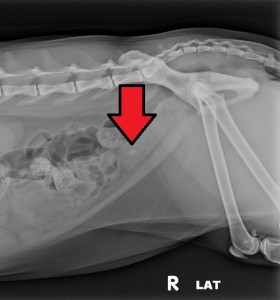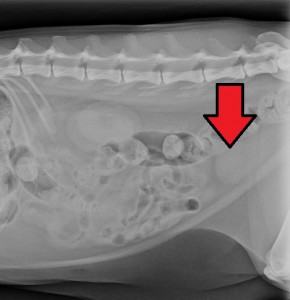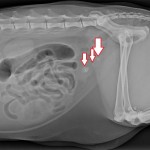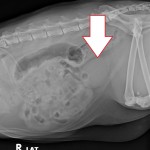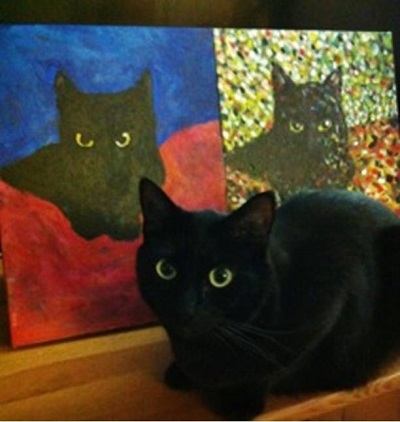
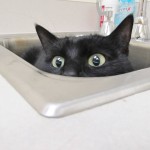 Examining a cat with inappropriate urination
Examining a cat with inappropriate urination
Dr. Wedde looked at her appointment schedule. Her next appointment was Nana, a 3 year old, female black cat. Nana had been using the litter box more frequently and urinated on her owner’s bed the night before. “Another cat with inappropriate urination,” thought Dr. Wedde. “I wonder what’s causing it this time.” She made a mental list of possible causes then went in to the room to examine sweet little Nana.
 Nana was great for her exam and allowed Dr. Wedde to get a good feel of her belly. She could feel that each kidney was smooth and normal in size and that the intestines seemed normal as well. However, when she felt the bladder, there was something there, “could that be a stone? Or is it just a piece of fecal matter in the colon next to the bladder?” thought Dr. Wedde. Then as she was still feeling the bladder, Nana urinated a small amount of red tinged urine. “Ouch!” thought Dr. Wedde. “Poor Nana has a very inflamed and bloody urinary bladder and a possible bladder stone as well!” Dr. Wedde discussed the next steps with Nana’s owner, explaining that the urine sample would need to be analyzed by the lab and cultured to check for bacteria. An x-ray of Nana’s abdomen was also important to determine if there was a stone in the bladder or not.
Nana was great for her exam and allowed Dr. Wedde to get a good feel of her belly. She could feel that each kidney was smooth and normal in size and that the intestines seemed normal as well. However, when she felt the bladder, there was something there, “could that be a stone? Or is it just a piece of fecal matter in the colon next to the bladder?” thought Dr. Wedde. Then as she was still feeling the bladder, Nana urinated a small amount of red tinged urine. “Ouch!” thought Dr. Wedde. “Poor Nana has a very inflamed and bloody urinary bladder and a possible bladder stone as well!” Dr. Wedde discussed the next steps with Nana’s owner, explaining that the urine sample would need to be analyzed by the lab and cultured to check for bacteria. An x-ray of Nana’s abdomen was also important to determine if there was a stone in the bladder or not.
The x-ray confirmed that there was indeed a stone present in Nana’s urinary bladder. The majority of bladder stones in cats are a type of stone called Struvite stones, which are made up of Magnesium, Ammonium and Phosphate. These three substances are common in urine, but if there is a high concentration of them in the urine, they will begin to form crystals. With the right circumstances, those crystals can bunch together to form stones as well. Luckily, most of these stones will dissolve with dietary therapy alone. The goals of dietary therapy are to lower the levels of magnesium and phosphorus, to adjust the acidity of the urine and to decrease inflammation with omega-3 fatty acids.
All of these factors help to decrease the formation of new crystals and dissolve struvite stones which meets all of the above goals for dietary therapy. She was also sent home with pain medications to help her feel more comfortable. The urine culture was positive for bacteria so Nana was also placed on a two week course of antibiotics. Nana was feeling much better within just a few days. About a month later, x-rays were repeated and confirmed that the stone had dissolved! Nana will continue to be fed the prescription diet to prevent stones from reforming and will hopefully never have this problem again.
The below photo shows multiple bladder stones found in another patient.
To read more about Bladder Stones in Cats, please click on the following links: http://www.veterinarypartner.com/Content.plx?P=A&S=0&C=0&A=3306 http://www.vet.cornell.edu/fhc/Health_Information/BladderandKidneyStones.cfm

 6512 12th Ave NE
6512 12th Ave NE
